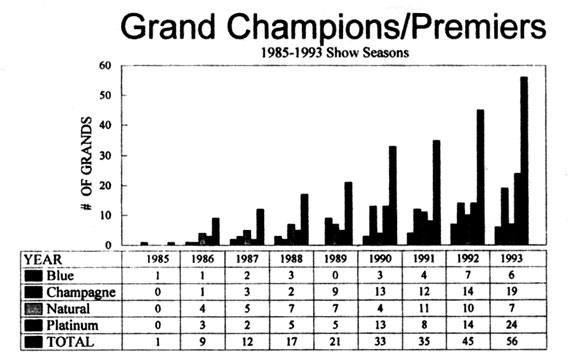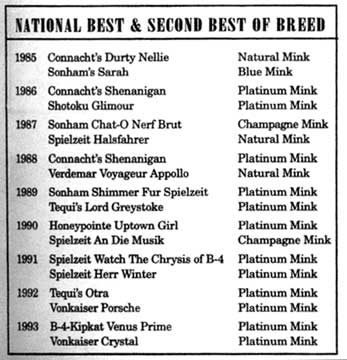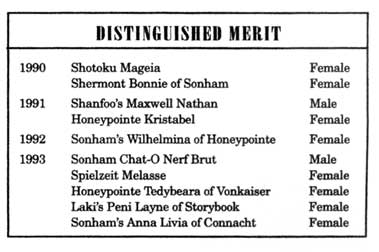The Tonkinese:
The 10th Anniversery
by Sharon Roy,
Shanfoo Cattery
CFA Almanac
May 1994
PERSEVERANCE AND TENACITY TRIUMPH!
February, 1984, San Diego, Ca.--The Tonkinese Breed was accepted into championship
status with The Cat Fanciers Association
culminating many years of dedication and perseverance of Tonkinese breeders
and enthusiasts coast to coast.
FROM CONTROVERSY TO COMMUNITY
Throughout their history, the Tonkinese breed has always been the subject
of much controversy. It is not my
intention to discuss the very early history of the breed.* Rather, I would
like this article to be a brief overview of the Tonkinese Breed during the
past twenty five years including the cats and the people who helped shape
this very popular breed. Hopefully,
this article will show just how far the Tonkinese have come in becoming vital
contributing members of the Cat Fancy Community.
This history cannot be complete without the mention of a few early breeders
whose excitement for the young breed helped shape their style and their future.
Today's breeders and exhibitors owe much of the success they enjoy
today to these early pioneers.
Margaret Conroy, of Canada, helped to write the first standard for the breed.
She guided the breed's acceptance into the Canadian Cat Association,
the first major registry to accept the Tonkinese for full championship status
in 1971.
In the United States, much credit for the early development of the breed
belongs to Jane Barletta of Trenton NJ.
Jane helped establish communications between breeders from coast to
coast. She collaborated with Margaret
Conroy to draft the early written standard.
In addition, she helped link the efforts being undertaken on the
West coast with those on the East coast, when, in 1969, she placed an advertisement
in Cat Fancy magazine. This led
to communication with Mary Swanson of Fresno Ca. who was also developing
her own line of early Tonkinese.
Jane Barletta also appeared on the original daytime "Jeopardy" show in the
early seventies. When asked for
a personal profile, she told the television audience that she was breeding
Tonkinese cats. Watching that show
was Joan Weber of Derry, NH. Joan
was also breeding Tonkinese and working closely with other early New England
Breeders, Hope Tremblay, Madalyn Dakin and Judy Penna.
Joan Weber wrote to the network and her letter was forwarded to
Jane Barletta. It was this correspondence
that led to the first organized Tonkinese meeting in Boston MA. in 1971.
This meeting was the beginning of the Tonkinese Breed Club and of an organized
effort coast to coast to achieve show status in all associations.
It was the beginning of the Tonkinese Community.
I purchased my first Tonkinese in 1976 and attended my first Tonkinese Breed Club meeting in 1977. Also attending her first meeting was Joan Bernstein of Long Island, NY.
In October 1978, under the guidance of the Tonkinese Breed Club, Joan Bernstein
volunteered to represent the Tonkinese at the October Board Meeting of CFA.
It was at this meeting that CFA agreed to accept the breed for registration.
The paperwork to register all known Tonkinese was completed in May
1979 and Tonkinese began showing up in CFA shows across the country.
In the summer of 1979, The Tonkinese Breed Association was chartered
as a CFA club.
The Tonkinese experienced setbacks along the way.
The Breed Association planned to ask for Provisional Status at the
February 1980 Board Meeting. The
then new "Five Year Rule" for the advancement of New Breeds and Colors passed
at the October 1979 meeting. This
rule established the non-competitive Miscellaneous class where it was expected
a new breed would remain for five years before being considered for advancement
into the Provisional class. It was
generally believed that this rule was written specifically for the Tonkinese
as an attempt to hold them in abeyance until they could prove themselves
or maybe just disappear. "Zonk the
Tonk" buttons appeared and the Tonkinese became the most controversial breed
to come about in many, many years.
What the opposition hadn't counted on was the zeal and abundant energy of
those dedicated breeders. The Tonkinese
attended shows in great numbers, fastly becoming one of the most popular
breeds in the showhall. The public
loved the breed! Even pet owners
supported the cause by joining the breed club, attending local shows as a
sign of support and some even providing monetary donations to keep the effort
alive. It was truly amazing to see
the Tonkinese breeders put aside their personal differences and combine their
energies to work for what seemed to be an unattainable goal.
Finally, in October 1981, The CFA Board advanced the breed to Provisional
status. February, 1984 saw the final
advancement into championship.
GOING FOR THE PLATINUM
What's become of the breed since May 1984, when the first Tonkinese took
their place in the CFA competive ring?
All has not been smooth sailing.
Although many came close, the first season, 1984-1985, saw only one Tonkinese
achieve Grand Premiership, Solano's Marina Del Sol of Risu, a Blue Mink spay
bred by Jean Cole and owned by Susan Mundell.
The first Grand Champion, Connacht's Shenanigan, a Platinum Mink
male bred and owned by Frank Yaccino and Larry Rhinard occurred in the first
show of May 1985. Following closely,
during the second weekend of May, was Shotoku Glimour, a Platinum Mink female,
bred and owned by Joan Bernstein.
This was only the beginning of the dominance of the Platinum Mink.
Throughout the next nine years, the Platinums have continually dominated
the show ring wins for Tonkinese.
Other distinguished Platinums include the following:
Shotuko Maggeia, a Platinum female bred and owned by Joan Bernstein, the first Tonkinese to receive the prestigious Distinguished Merit Award.
Honeypointe Uptown Girl, a Platinum female, bred and owned by Rico and Barbara
Honey, the First and Only Tonkinese to achieve a National Top Win.
This win was in Premiership in the 1990 show season.
Spielzeit Watch the Chrysis of B4, a Platinum male, bred by Bruce and Fran
Nickerson and owned by the Nickersons and Ken Burke who, to date, is the
highest scoring Tonkinese in history.
OTHER MEMORABLE TONIKINESE
The following Tonkinese merit recognition and should be remembered if the
recorded history of the breed is to remain intact:
Connacht's Durty Nellie, a Natural Mink female bred and owned by Frank Yaccino
and Larry Rhinard, the first NationaL Best of Breed with CFA.
Shanfoo's Maxwell Nathan, a Natural Mink male, bred and owned by Norma and
Sharon Roy, the first Tonkinese male Distinguished Merit winner, sire of
17 Natural Mink Grands.
Sonham Chat o Nerf Brut, a Champagne Mink male, bred and owned by Mary Mosshammer
and Ann Sanson, A National Best of Breed who also went on to become a DM.
Brut is also the second highest scoring Tonkinese in CFA history.
Shermont Bonnie of Sonham, A Natural Point (AOV Non-championship color),
the first Tonkinese AOV to achieve a Distinguished merit.
BiHo Meiling, a Natural Mink female, bred and owned by Hope Tremblay, the
first Tonkinese to achieve a
grand championship in any association.
Meiling received her award in 1981 with Cat Fanciers Federation.
Chatain's Nathan of Shanfoo, a Natural Mink male, bred by Mary Swanson and
owned by Norma and Sharon Roy, the first alter to achieve a Grand and the
first Tonkinese to achieve a National Top Ten win, with Cat Fanciers Federation
in 1982.
THE LOOK,
THE STYLE, THE COLORS
Many years of selective breeding have given the Tonkinese a style and a look
all their own. The breed has developed
an overall consistency in type. For
the past ten years, the Tonkinese breeding program has allowed Tonkinese
to Tonkinese crosses only. With championship
status came the elimination of all first generation Siamese to Burmese outcrosses.
Ideal Tonkinese have no extremes.
They should never resemble either of their parent breeds.
Their body is medium in length, with the height of their legs approximately
equal to the length of their body.
Ideal tail length should be equal to their body length.
The head is a modified wedge (not round) and should be slightly
longer than it is wide. The muzzle
is blunt. The eye shape is open almond (not round) but slightly rounded along
the bottom, slanted upward along the cheekbone, medium in size in proportion
to the head.** The ear set is oval, set as much on top as on the side of
the head.
Currently, Tonkinese are accepted
for championship in four colors, Natural Mink, Champagne Mink, Blue
Mink and Platinum Mink. Although
early breeders did not recognize the Platinum color, Cathy Rokaw, in 1978
suggested the Platinum would have to exist if we were to be consistent with
our Siamese/Burmese heritage. In
1979, the first Platinum was officially produced.
The original standard used the word "Mink" to describe the look
and feel of the Tonkinese coat. Over the years, its use has become synonymous
with the intermediate range of championship colors.
THE AOV'S
Two AOV colors are recognized for each accepted color, a Pointed (Siamese) color and a Solid (Burmese) color. According to the genetic ratio, 50% of all Tonkinese produced are AOV's and are not showable. Breeding Mink Tonkinese to Mink Tonkinese should produce a ratio of 25% pointed, 25% solid and 50% mink colored Tonkinese. Breeding a Pointed AOV to a Solid AOV will produce 100% mink Tonkinese.
The AOV's are a natural output of our breeding programs and have proven to
be a valuable asset. The question
of their future status as show colors has been put on hold over the past
years as our focus has been placed almost entirely on perfecting type and
consistency. Many times an AOV has
been the "pick" of a litter. In these
days of a tight economy, greater show expenses and animal restrictions in
many communities, perhaps it is time to rethink our view of the AOV and the
acceptance of these colors into championship.
Whatever the outcome, this is a controversial issue within the breed
that will most likely spark debate in breed council discussions for years
to come.
THE PERSONALITY
The Tonkinese has always been popular with the general public who visit and
support our shows. The spectators
are initially attracted to the unusual color and the unique aqua eye color.
But it is the Tonkinese personality that usually hooks them into
becoming lifelong devotees of the breed. In reality, most Tonkinese breeders
have a waiting list for their available pet kittens.
The Tonkinese seem to crave attention, affection and companionship.
Their playful antics can melt the heart of even their strongest
critics. They can be happy playing
with a group of children one minute and curling up on the lap of citizen
the next. The Tonkinese may grow
old but rarely do they grow up.
* An informative article on the early days of Tonkinese can be found in the
1980 CFA Yearbook, "Those Terrific Tonkinese” by Joan Bernstein.
** In 1991, the Tonkinese Breed Council added a penalize for “round eyes” in an attempt to stop the growing trend of judges and breeders to select for the rounder eyed cat.
I would like to thank Mary Swanson and Jane Barletta for sharing with me their early memories of the breed, to all the breeders who sent me pictures, to Lisa Gosselin and Larry Rhinard for their proof reading and to Jack Ryley for his help with display graphs.
Photos slow loading


